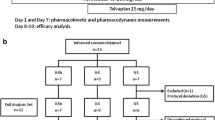Conclusion
Within a population of patients with congestive heart failure (NYHA class III–IV), pharmacokinetics and pharmacodynamics of furosemide are hardly influenced by the state of compensation (in terms of presence or absence of massive edema). High dose furosemide (more than 1,000 mg a day) can be effective in the treatment of patients with refractory congestive heart failure as well as in the management of haemodialysis patients with residual diuresis. Continuous infusion is the most efficient and effective mode of furosemide administration (in healthy volunteers). Continuous infusion of furosemide is effective in the treatment of patients with refractory congestive heart failure. Furosemide treatment with a maximal infusion rate of 160 mg/h can be given safely under careful clinical and electrolyte control.
Similar content being viewed by others
Author information
Authors and Affiliations
Rights and permissions
About this article
Cite this article
van Meyel, J.J.M. Clinical pharmacological studies on furosemide. Pharm World Sci 16, 29–31 (1994). https://doi.org/10.1007/BF01870937
Issue Date:
DOI: https://doi.org/10.1007/BF01870937




